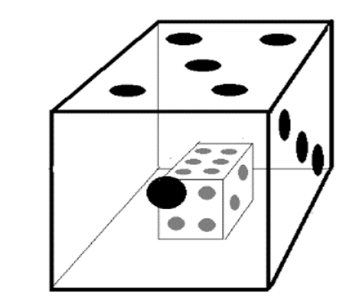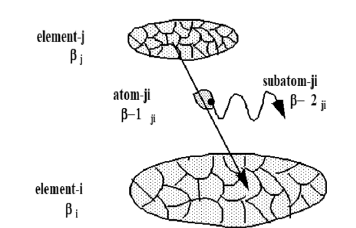- Submissions

Full Text
Novel Research in Sciences
Universality of Quantum Mechanics and Boltzmann Statistical Mechanics
Siavash H Sohrab*
Department of Mechanical Engineering, Robert McCormick School of Engineering and Applied Science, Northwestern University, USA
*Corresponding author:Siavash H Sohrab, Department of Mechanical Engineering, Robert McCormick School of Engineering and Applied Science, Northwestern University, USA
Submission: January 09, 2023;Published: January 18, 2023
.jpg)
Volume13 Issue2January , 2023
Opinion
Our universe involves statistical fields at five major scales that are separated by a factor of 10-17, beginning at exceedingly small Planck scale of 10-35m, electrodynamics 10-18m, hydrodynamics 100m, astrophysics 1018m, and finally galactic-dynamics (cosmology) 1035m, having “atomic” particles: graviton, electron, fluid element, star, and galaxy [1]. A schematic of hierarchies of statistical fields from photonic to cosmic scale and associated model of embedded dice are shown in Figures 1 & 2. Every statistical field shown in Figure 1 has (atom. element. system) length scales (l, , L) and each statistical system is composed of a spectrum of elements, also called clusters or energy-levels, that contain corresponding spectrum of “atoms”. The question that was asked by both Boltzmann and Planck is: given the total number of atoms N and the total system energy H, what is the distribution of cluster sizes Nj corresponding to stochastically stationary field. Such a state of thermodynamic equilibrium corresponds to energy, speed, and velocity of “atoms” being governed by invariant Planck, Maxwell-Boltzmann, and Gauss (Maxwell) distribution functions [1]. The thermodynamic probability of each level is identified as the inverse of what Boltzmann called number of complexions Wj and is given by [2].
Figure 1: A scale-invariant model of statistical mechanics from photonic to cosmic scales.

Figure 2: Hierarchies of embedded dice.


Atomic internal energy uj gives the cluster internal energy Uj = Njuj and Boltzmann principle of equipartition of energy requires all clusters internal energy identical to that of the most probable or Wien cluster Ui = Uj = ... = Uwsub>= Nwuw= 3NwkT. Equation (1) leads to scale-invariant Planck energy distribution [2] and derivation of invariant Schrödinger equation from invariant Bernoulli equation [1]. Therefore, the entire hierarchy of statistical fields shown in Figure 1 will be governed by quantum mechanics and follow invariant Schrödinger equation [1]. The fact that Boltzmann anticipated quantum mechanics by about three decades is evidenced by the following quotation taken from his pioneering and often neglected 1872 paper [3].
“We wish to replace the continuous variable x by a series of discrete values 1, 2, 3 … p. Hence, we must assume that our molecules are not able to take up a continuous series of kinetic energy values, but rather only values that are multiples of a certain quantity ε. Otherwise, we shall treat exactly the same problem as before. We have many gas molecules in space R. They are able to have only the following kinetic energies:

No molecule may have an intermediate or greater energy. When two molecules collide, they can change their kinetic energies in many different ways. However, after the collision the kinetic energy of each molecule must always be a multiple of ε”.
The importance of Boltzmann’s contributions to the foundation of quantum mechanics was emphasized by Planck in his Nobel Lecture [4]. Also, even though Einstein did not mention the importance of Boltzmann’s theories in his autobiographical sketch [4].
“Not acquainted with the earlier investigations of Boltzmann and Gibbs which appeared earlier and which actually exhausted the subject, I developed the statistical mechanics and the molecular kinetic theory of thermodynamics which was based on the former.”
much earlier in1900 Einstein did praise Boltzmann’s work in a letter to Mileva [4].
“The Boltzmann is magnificent. I have almost finished it. He is a masterly expounder. I am firmly convinced that the principles of the theory are right, which means that I am convinced that in the case of gases we are really dealing with discrete mass points of definite size, which are moving according to certain conditions.”.
Similar high praise of Boltzmann’s theory appeared in April 1901 letter of Einstein to Mileva [5].
“I am presently studying Boltzmann’s gas theory again. It is all very good, but not enough emphasis is placed on a comparison with reality. But I think that there is enough empirical material for our investigation in O. E. Meyer. You can check it the next time you are in the library. But this can wait until I get back from Switzerland. In general, I think this book deserves to be studied more carefully.”
Also, the central role of Boltzmann in Einstein’s work on statistical mechanics has been recently emphasized by Renn J et al. [5].
“In this work I argue that statistical mechanics, at least in the version published by Einstein in 1902 (Einstein1902b), was the interpretation of already existing results by Boltzmann.”
Some have argued that lack of appreciation and neglect of Boltzmann scientific contributions may have played a major role in his suicide in 1906, one year after 1905 or so-called Einstein miracle year!!. However, in the present author’s opinion, the ocean of scientific and philosophical knowledge of Boltzmann was too deep and wide to be influenced by such minor perturbations. At the time, there was also little attention paid to Einstein and his research since the scientific community was aware of Sutherland 1902’s contribution to the problems of size of molecules as well as Brownian motions [2]. Moreover, many scientists believed in Poincaré-Lorentz dynamic theory of relativity as opposed Einstein kinematic theory of relativity [1] as evidenced by the statement of Poincaré in his 1912 London lecture [2].
“Today some physicists want to adopt a new convention. It is not that they are constrained to do so; they consider this convention more convenient; that is all. And those who are not of this opinion can legitimately retain the old one in order not to disturb their old habits. I believe, just between us, that this is what they shall do for a long time to come,”
as well as Lorentz in his 1915 lecture at the Royal Academy of Sciences in Amsterdam [6].
“I could point out to you [if I had more time] how Poincaré in his study of dynamics of electron, about the same time as Einstein, formulated many ideas that are characteristic for his theory, and also formulated what he calls “le postulat de relativité.”
Finally, besides the little known work of Olin to De Pretto in 1904 [2], Hasenöhrl 1905 pioneering contribution to mass-energy equivalence given by his formula for total energy [1].

as compared to Einstein formula for electromagnetic energy

was widely known, particularly in scientific circles of Vienna. Transition of an atom from high energy-level-j to low energylevel- i will result in emission of a “sub-particle” sji to carry away the excess energy given by Bohr frequency formula [1]. Atomic transitions between stochastically-stationary clusters is in harmony with transitions between “cells” in recent cellular automaton interpretation of quantum mechanics [7]. A schematic diagram showing generalized transition between a small rapidly oscillating element-j (High energy level j) and a large slowly oscillating element-i (low energy level-i) is shown in Figure 3.
Figure 3: Generalized transition of atom aji from element-j to element-i leading to emission of sub-particle sji.

Notwithstanding the often-quoted statement by Einstein “God does not play dice”, according to Figure 1, Almighty appears to be playing with an infinite number of embedded dice. Therefore, the question is not whether Almighty plays dice but rather, “How does God play dice?” according to ‘t Hooft G [8]. The question is whether or not universality of quantum mechanics leaves any room whatever for Laplace’s deterministic world of classical mechanics. It appears that the answer is affirmative due to different domains of applicability of quantum versus classical mechanics in harmony with the perceptions of Heisenberg [2].
“We no longer say “Newtonian mechanics is false and must be replaced by quantum mechanics, which is correct.” Instead, we adopt the formula “Classical mechanics is a consistent self-enclosed scientific theory. It is a strictly correct description of nature wherever its concepts can be applied”.
The quantum nature of internal space-time as well as external space and time and their infinite divisibility according to the philosophy of Anaxagoras discussed in [1], suggest that probability is an intrinsic and indispensable feature of Casimir vacuum [1] and hence quantum field theory.
References
- Sohrab SH (2022) 14th chaotic modeling and simulation international conference (springer proceedings in complexity), Skiadas CH, Kimotikalis Y (Eds.), (1st edn), Springer Nature, Switzerland, Europe.
- Sohrab SH (2015) On a scale invariant model of statistical mechanics, kinetic theory of ideal gas, and Riemann hypothesis. IJMCTR 3(6): 7-37.
- Boltzmann L (1872) Further studies on the heat balance among gas molecules, session reports academic, Part II, Virginia, USA, pp. 267-370.
- Cercignani C (1998) Ludwig Boltzmann, the man who trusted atoms. Oxford University Press, USA.
- Renn J, Schulmann R (1992) Albert Einstein mileva maric, The love letters, Princeton University Press, Princeton, USA, pp. 32-47.
- Verhulst F (2012) Henri Poincaré, Impatient Genius, Springer, p. 64.
- Hooft ‘t G (2016) The cellular automaton interpretation of quantum mechanics, Springer.
- Hooft ‘t G (2001) How does God play dice? (Pre-) determinism at the Planck scale, Netherlands.
© 2023 Siavash H Sohrab. This is an open access article distributed under the terms of the Creative Commons Attribution License , which permits unrestricted use, distribution, and build upon your work non-commercially.
 a Creative Commons Attribution 4.0 International License. Based on a work at www.crimsonpublishers.com.
Best viewed in
a Creative Commons Attribution 4.0 International License. Based on a work at www.crimsonpublishers.com.
Best viewed in 







.jpg)






























 Editorial Board Registrations
Editorial Board Registrations Submit your Article
Submit your Article Refer a Friend
Refer a Friend Advertise With Us
Advertise With Us
.jpg)






.jpg)














.bmp)
.jpg)
.png)
.jpg)










.jpg)






.png)

.png)



.png)






